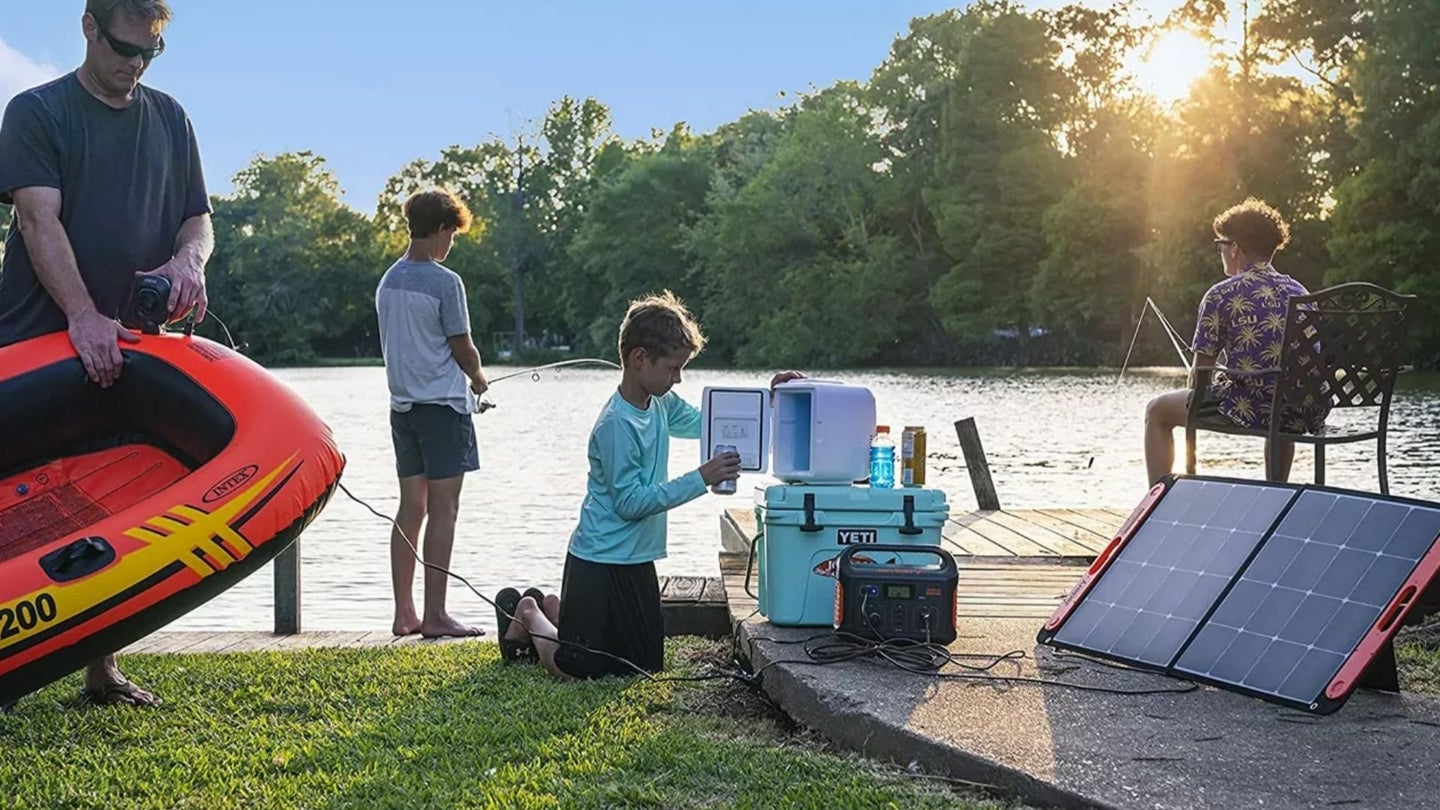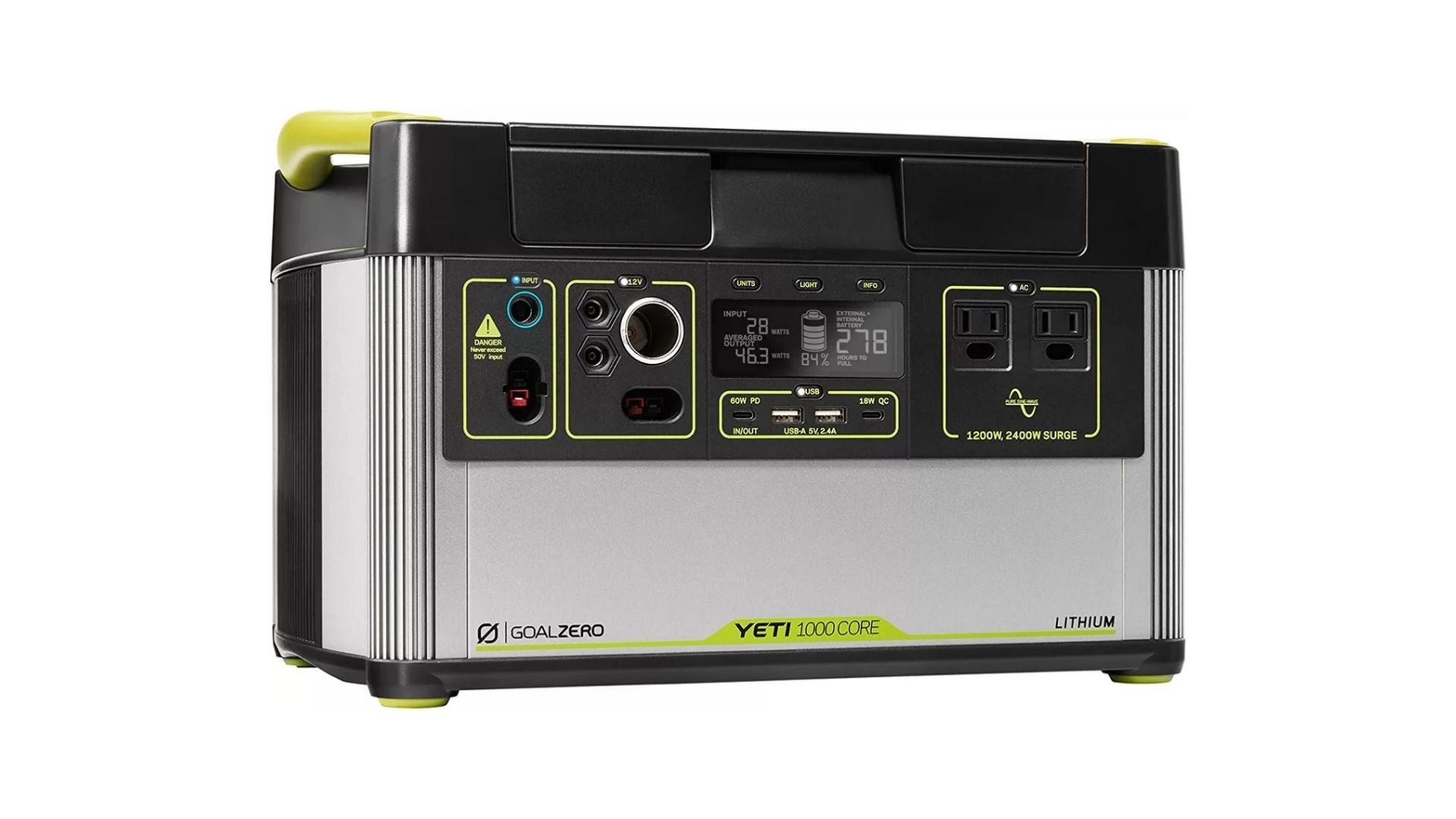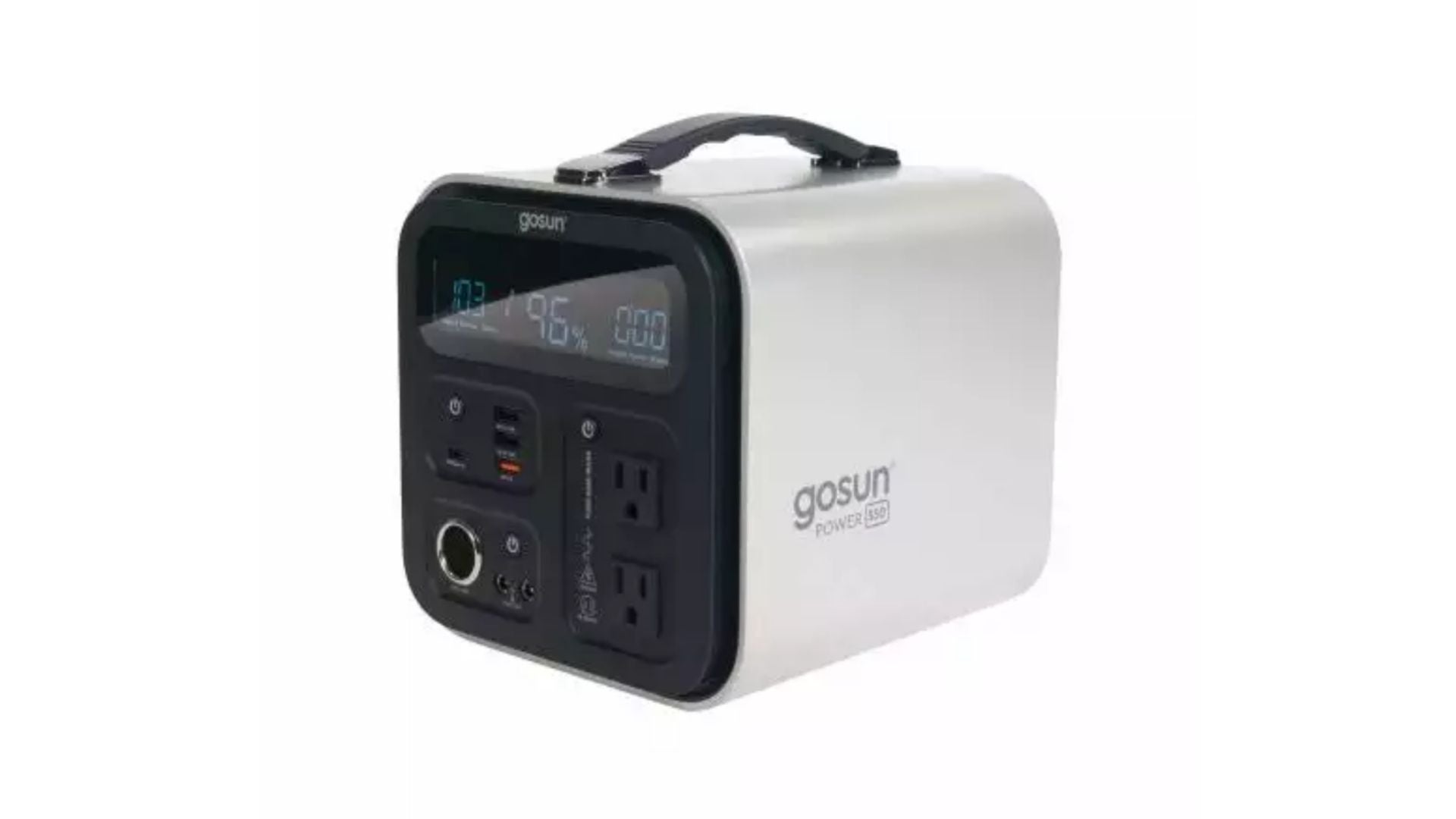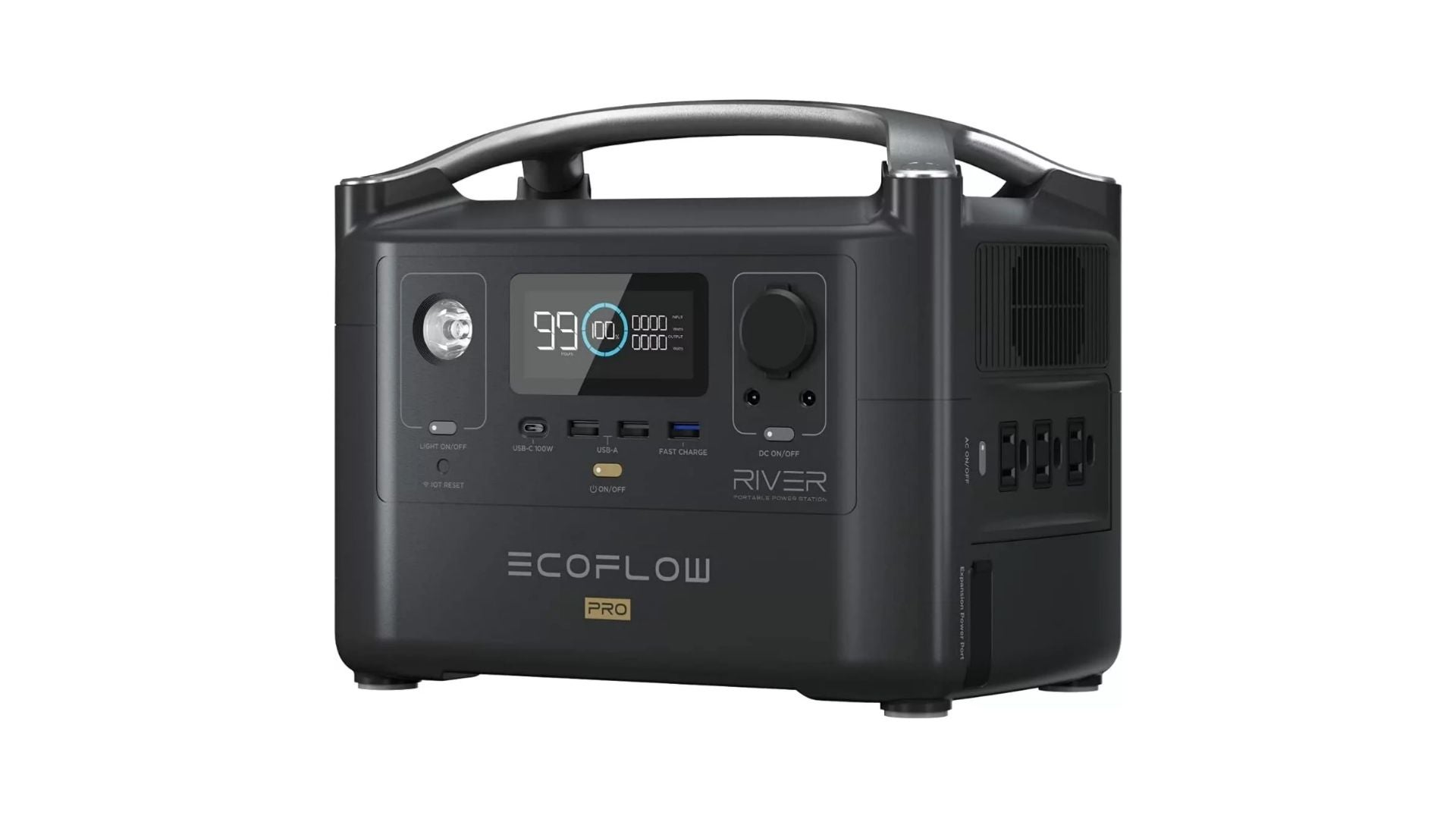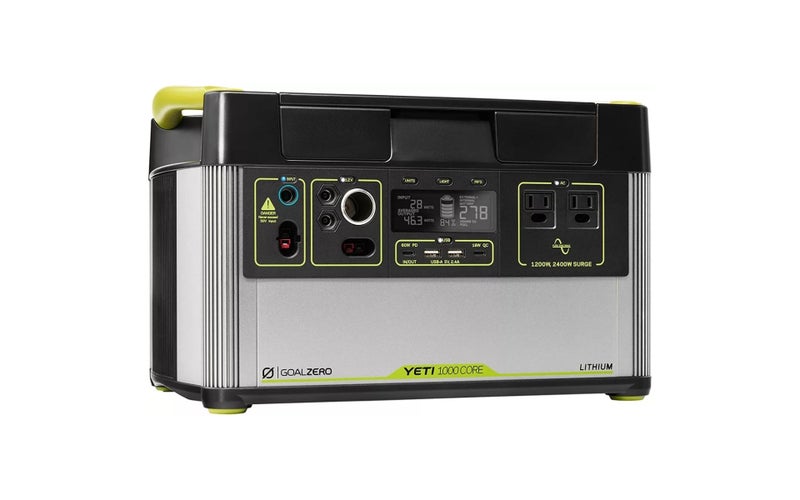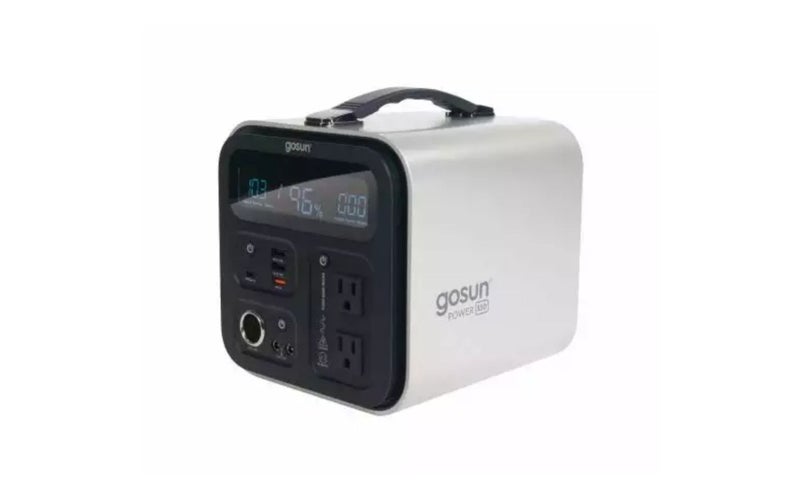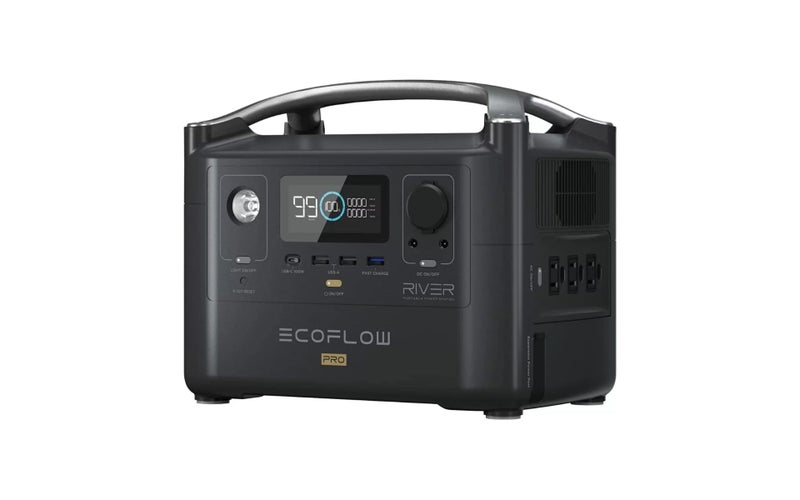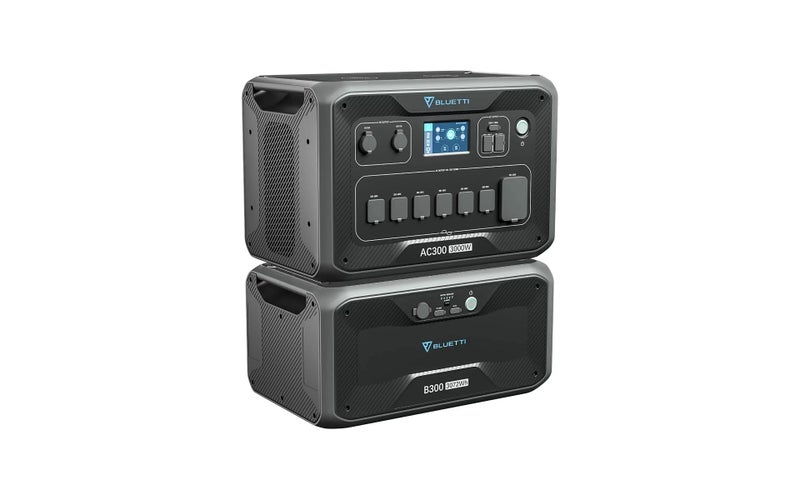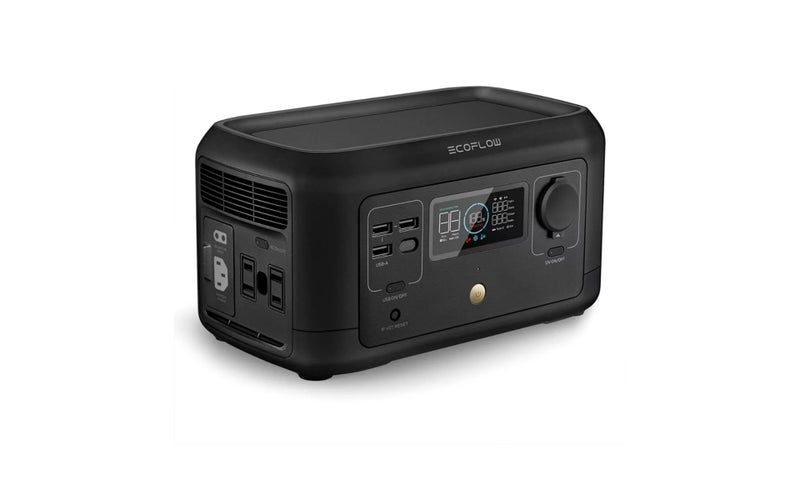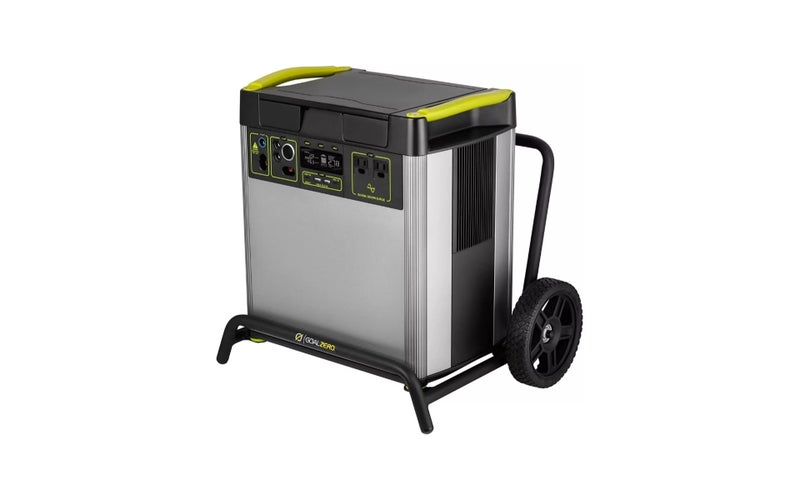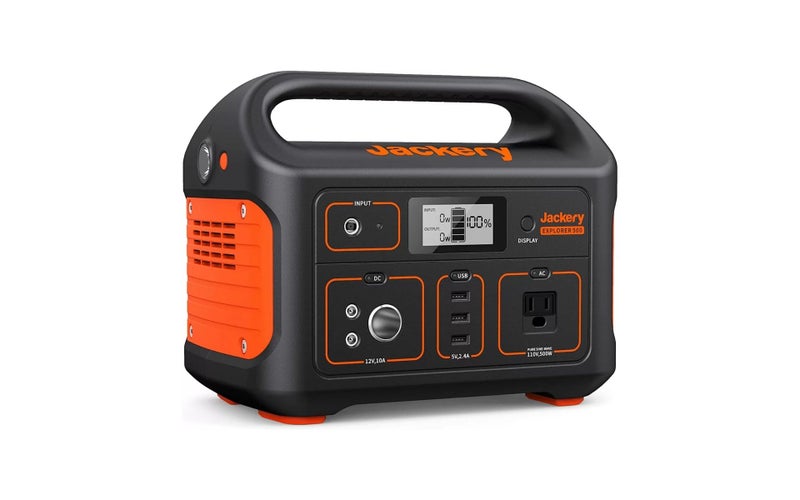We may earn revenue from the products available on this page and participate in affiliate programs.
When it comes to being self-sufficient and prepared for anything, solar generators are one of the best investments you can make. When freak ice storms bombarded Texas in 2021, millions of people suddenly realized how perilous our access to energy actually is.
Even though a full-scale home solar setup might price out a lot of homeowners (and all renters), solar generators like the ones we included on this list present a much more accessible alternative. All the solar generators we picked can be powered from a wall outlet and be used as an emergency reserve, but they can also be paired with solar panels to reduce your monthly electric bill. If you have a beer fridge in the garage or a space heater in a workshop, a small solar setup can pay itself off surprisingly quickly.
A solar generator consists of a solar panel array and a power station. Both components are important; each can be used alone, but they do best as a team. We won’t suggest that it doesn’t matter which solar panels you choose, but most people will do well to decide on the power station first. That’s what we focused on for this gear guide. Once you choose the right one for you, decide how fast you need the battery topped off when you can’t access the grid and find a compatible solar array from that brand.
There’s a lot more to learn before you make this kind of investment, so let’s identify some of the best solar generators and make sense of the technology that powers them.
Methodology
There was a time when, like most people, we thought solar energy was a simple concept: plug a solar panel into a solar generator and off you go. Enjoy your free electricity. It turns out that there’s a lot more to it than that. Solar energy that’s collected by one of several kinds of solar panels needs to be regulated to ensure safe delivery into the battery. The solar generator needs to convert stored energy into a form that can be used by devices that consume either alternating- or direct-current electricity.
To make sure you got solid information, we spent days researching all of this and found some great resources to pass along. Armed with that information, we sought out solar generators that are adequate for several days of use on a single charge. Every product that made our list had to offer AC and DC charging. The ability to charge via solar panels was obviously a must, but we looked for solar generators that can be purchased individually so you have the flexibility to customize a setup to meet your specific needs. Finally, we gave priority to brands that either had a proven record of success or could provide a product for us to test for ourselves.
One of the main reasons we buy solar generators is the fact that we don’t know what the future holds. Uncertainty is exactly where Goal Zero thrives, and the Yeti 1000 Core might be the best buy in its product lineup.
Like many of the best solar generators, the Yeti 1000 Core has a storage capacity just 17 shy of 1,000 watt-hours. Where this one shines is performance in the face of the elements. In addition to being one of the oldest and most trusted manufacturers of solar products, Goal Zero has earned a reputation for making solar panels, generators, and batteries that can take a beating without letting you down.
The Yeti 1000 Core can be charged with a maximum input of 300 watts, which is easily attainable with Goal Zero’s chainable solar panels or the standard power cord. From there, the lithium-ion battery can handle coolers, grills, and other camping appliances. At 32 pounds, it’s an easy addition to your car camping setup or bug-out kit.
The Yeti 1000 Core is based on the Yeti 1000X. Goal Zero is a premium brand and usually costs more than others. To close that gap, the company scaled back the Yeti 1000X to get the price more in line with the competition. We think the result hits a sweet spot for anyone looking to upgrade their camping experience and prepare for the worst at the same time.
- Storage: 983 watt-hours
- Maximum input: 300 watts
- Maximum regulated output: 1,200 watts
- Maximum surge output: 2,400 watts
- Battery chemistry: Lithium-ion
- Weight: 32 pounds
A more affordable take on the popular Yeti 1000X
Unflinchingly rugged construction is ready for adventure
Charges in four hours with 300 watts of solar power
Carbon-neutral shipping, headquarters, and warehouse
Slightly less capable than the Yeti 1000x
Cannot be chained with external batteries
There’s a lot to learn about solar power for those who are new to the scene, and some products make getting up to speed easier than others. The GoSun might not have the chops of our other picks, but it’s so accessible and user-friendly that it deserves consideration by solar newcomers.
GoSun doesn’t have the same brand recognition as the other manufacturers on our list, but we were able to get a Power 550 and 100-watt solar panel for testing. Both are about as user-friendly as it gets. The Power 550 includes a variety of AC and DC charging ports that can be used simultaneously. Its compact size and light weight are great for short trips or working off-grid. We used ours to charge household electronics and power things like heated blankets during the winter. The color display is one of the largest we’ve seen, and it makes it easy to monitor input, output, battery life, and the status of all active ports. Someone who has no knowledge of solar generators would be in pretty good shape with this one.
In terms of outright performance, the Power 550 lags behind the other options on this list. It takes quite a while to charge and is not weather-resistant. You aren’t going to find this on any prepper’s gear list. On the other hand, it’s a great way to keep your laptop, phone, and earbuds charged. If vanlife or remote weekend getaways are your idea of a good time — and learning the ins and outs of solar energy is not — this is a solid choice.
- Storage: 550 watt-hours
- Maximum input: 300 watts
- Maximum regulated output: 600 watts
- Maximum surge output: 1,200 watts
- Battery chemistry: Lithium-ion
- Weight: 15 pounds
Affordable way to get into the solar game
Detailed, user-friendly color display
Nice selection of AC and DC power ports
Compact and portable
Better suited to small devices
Long charge times for its size
For most people, choosing between a 500-watt-hour solar generator and a 1,000-watt-hour solar generator is an easy decision. If you’re the exception to the rule, The EcoFlow River Pro might be just what you need. This 720-watt-hour solar generator offers high-end quality at a more accessible price by cutting down on power you don’t need.
Charging time is the River Pro’s party trick. You can achieve a full charge in about 90 minutes. From there, the River Pro is powerful enough to charge your phone more than a hundred times or run a refrigerator for at least eight hours. Its array of charging ports lets you power 10 devices at the same time and access a maximum regulated output of 600 watts. If that’s not enough, you can add an extra battery to bring the available power up to 1,440 watt-hours. The lithium-ion battery keeps things light, so the whole package weighs in at just 17 pounds. EcoFlow backs up the River Pro with a two-year warranty and 24-hour customer service.
Versatility is this solar generator’s greatest strength, but it can also be a drawback. For some buyers, 720 watt-hours is inadequate; for others, it’s excessive. That’s the price of occupying the middle ground. Still, it’s one of the best solar generators out there if you want something fast and reliable.
- Storage: 720 watt-hours
- Maximum input: 660 watts
- Maximum regulated output: 600 watts
- Maximum surge output: 1,200 watts
- Battery chemistry: Lithium-ion
- Weight: 17 pounds
Recharge time is impressively fast
Add external River batteries to increase capacity
Surprisingly light for its segment
Charging ports for 10 devices
Inadequate power for a home or RV
Shorter lifespan than some of the competition
When it comes to specialized gear, what some see as a disadvantage may be a major selling point for someone else. That’s true of the Bluetti AC300, which corners a unique market with unconventional battery chemistry.
Every other solar generator on this list uses a lithium-ion battery. That’s primarily because lithium-ion batteries can store more energy per pound, making them the go-to battery when weight is a concern. The Bluetti AC300 uses a lithium iron phosphate battery that’s significantly heavier. That’s fine by us because it holds a charge slightly longer, can survive more charge cycles, and is more stable. If you want to power your cabin or super-secret hideout, this is the way to go. We suppose it would also be fine to keep in your garage as a backup power source, even though that’s less exciting.
This kit combines an AC300 solar generator and a B300 external battery (with more batteries and solar panels available). That combination isn’t cheap, especially considering the solar charger starts with a considerable 3,000-watt-hour capacity. It’s also heavy, as we mentioned. Given all the pros and cons, this is probably the best solar generator to leave unattended, worry-free, for long periods of time.
- Storage: 3,000 watt-hours
- Maximum input: 5,400 watts
- Maximum regulated output: 3,000 watts
- Maximum surge output: 6,000 watts
- Battery chemistry: lithium iron phosphate
- Weight: 48 pounds
One-stop package for an off-grid setup
Add up to two external batteries and three solar panels
Fast charge times improve power capabilities
Lithium iron phosphate battery offers more charge cycles than lithium-ion
Far heavier than lithium-ion solar generators
Not a good portable option
If the EcoFlow River checks all your boxes but weighs too much, the River Mini is what you need. This compact, portable solar generator bridges the gap between full-size solar generators and pocket-size power banks.
The River Mini’s 200-watt-hour storage capacity is perfect for keeping your phone, laptop, earbuds, and smartwatch powered up on the go. Instead of targeting homeowners and preppers, EcoFlow built the River Mini for people who want to work (or play) remotely without having to compete for a plug at the local coffee shop or call it a day when batteries start dying. It recharges in 90 minutes and can be controlled with an app. The whole thing weighs just six pounds and costs less than $240 on sale (at the time of writing). A wireless charging option is available if you’re willing to spend a little more.
Unlike the other options on this list, the River Mini isn’t the best solar generator for camping, powering your home during a power outage, or bringing your campsite into the modern era. What it can do is go places the others can’t. Toss it in your backpack (or even your go-bag) for a little extra juice when a handheld power bank doesn’t cut it.
- Storage: 210 watt-hours
- Maximum input: 100 watts
- Maximum regulated output: 300 watts
- Maximum surge output: 600 watts
- Battery chemistry: NMC lithium-ion
- Weight: 6 pounds
Extremely light and portable
Fully charges in 90 minutes
Can be monitored and controlled with an app
Run input and output simultaneously
Low power output cannot support larger devices
Wireless charging option costs $100 more
To a lot of people, Goal Zero represents the best solar generators on the market. If they’re right, the Yeti 6000X might be as good as it gets because this behemoth occupies the top spot on the company’s power station food chain.
The Yeti 6000X goes far beyond what most consumers need by offering more than 6,000 watt-hours of energy, 2,000 watts of continuous, regulated output, and a surge output of 3,500 watts. It can be recharged by up to 600 watts and can handle Goal Zero’s highest-output solar panels. As if all that wasn’t enough, it can be combined with external Goal Zero batteries to stockpile even more electricity off the grid. If you’re looking for a power backup for your home, this is the one to have. It’s a powerful workhorse that can keep power-thirsty appliances up and running when the power lines fail you.
The Yeti 6000X comes at a hefty price, and costs will go up significantly if you want to get the most out of it with premium solar panels and batteries. Even though the power station comes on a rolling cart, 106 pounds is too much for practical camping and outdoor adventure. This is one solar generator that will probably be parked in your garage or basement and left alone.
- Storage: 6,071 watt-hours
- Maximum input: 600 watts
- Maximum regulated output: 2,000 watts
- Maximum surge output: 3,500 watts
- Battery chemistry: Lithium-ion
- Weight: 106 pounds
Incredibly powerful, self-contained home power backup
Can be paired with additional batteries for even more power
Adequate for multiple large appliances like refrigerators and power tools
Extremely durable and well-built
Includes a cart, but not practically mobile
Expensive to supply with maximum solar power
If you follow the overlanding and car camping communities, you’ll get the impression that Jackery is the brand to have. These orange solar power stations are becoming increasingly common sights on the trails and roads less traveled because they’re rugged, affordable, and get the job done.
Jackery solar generators seem to be one of the more trusted brands among consumers. Power stations like the Explorer 500 offer the performance people need for off-grid adventures, but keep costs down by eliminating features that aren’t essential. Sure, the housing looks like a plastic lunchbox and the screen could have been made in the 1980s, but you’d rather look at amazing natural views than your power station anyway. The Explorer 500 is built to be thrown in the back of your truck or SUV, taken to a campsite, and used to get the sun’s energy into smaller electronic devices like your camera and laptop.
With a capacity of 500 watt-hours, the Explorer isn’t cut out for larger charging jobs like refrigerators and heaters. For that, Jackery offers the Explorer 1000 and 1500. This one’s just right for overnight trips or car camping adventures where you’ll have plenty of opportunities to recharge the battery.
- Storage: 518 watt-hours
- Maximum input: 100 watts
- Maximum regulated output: 500 watts
- Maximum surge output: 1,000 watts
- Battery chemistry: Lithium-ion
- Weight: 13 pounds
Built to endure hard use outdoors
No-frills approach cuts costs without sacrificing quality
Balance of power and portability
Built-in light helps with after-dark setup
Not as many features as higher-end solar generators
Charge times are on the longer side
Our verdict on solar generators
At the end of the day, choosing the best solar generator for you comes down to capabilities. In most cases, we recommend the Goal Zero Yeti 1000 Core for its rugged reliability and just-right capacity. Alternatively, you can save a lot of money with a GoSun Power 550, which makes getting into solar energy intuitive and affordable. If you want to take your home off-grid with uninterrupted access to power, go big and hook up a Goal Zero Yeti 6000X with a few extra batteries and some permanent solar panels.
What to consider when buying solar generators
Investing in a solar power station can be a big investment, especially if you’re trying to power your home or RV. Doing a little homework about the types of systems available and their requirements can save you a lot of trouble (and money) in the long run. Hell, it might even make you money.
Types of solar generators
People began using the sun’s energy long before the solar generators we think of today came into being. A lens or piece of reflective material can be used to focus solar energy to create heat. Magnifying glasses can be used to start a fire; reflective panels can boil water in the field. Linear concentration systems like the one found in the Gosun Go camp stove can generate enough heat to cook a meal without any fuel except for daylight. The kinds of solar generators we’ll focus on, though, are ones that turn sunlight into electricity.
Portable solar generators
The easiest and most affordable way to take advantage of solar energy is with a portable system that contains all the components you need. The best portable solar generators are about the size of a lunchbox and have the ability to provide electricity via three-prong wall outlets, 12-volt outlets like the one in your car, and various sizes of USB ports. A display that shows how much power is being delivered and how much remains on tap will let you manage your consumption off-grid. How much power a given generator can store will depend on its size.
Even though you can typically charge your power station from the wall or your car, solar panels are preferable for their free access to solar energy. Be prepared to buy your panels separately from your solar power station, although some vendors do offer complete kits. There is some variety in the efficiency of various panel designs, but bigger is generally better when it comes to power output. Make sure you choose panels that are appropriate for your power station and energy needs.
Solar generators for home use
As of 2020, solar power plants produced a very small portion of the energy used in the U.S., but that doesn’t mean it can’t work (and be profitable) for you on an individual basis. The U.S. Department of Energy lists seven steps to take to equip your home with solar power. Basically, homeowners need to conduct an energy audit to see how much electricity they consume, then compare that figure to the energy potential of their property based on factors like available space, budget, light exposure, and weather patterns.
Solar panels are great at producing power, but they can’t store it. To keep your house operational around the clock, you’ll need batteries to store the electricity and a means of converting it to a form your appliances and devices can use. There’s a lot of important technology and careful math involved in setting up a solar generator for your home, but it can be done and systems are getting increasingly affordable. Many states also offer financial incentives to go solar.
Key features of solar generators
Solar panels
Solar panels are the components of a power system that capture the sun’s energy, to begin with. Underneath a clear, protective outer layer are rows of monocrystalline or polycrystalline silicon cells that absorb solar energy. A junction box on the back of each panel serves as the connection point between two panels or a panel and your generator and ensures that electricity only flows in one direction. All of your panels together are called an array. If you have a lot of electronics to power, need to recharge in a hurry, or have poor access to sunlight, increasing the size of your array can help you stay on top of your energy needs.
Because solar panels are intended for use outside, they’re built to be very durable. Don’t worry too much about the weather, but be careful not to bend or otherwise abuse your solar panels and risk cracking them. If you want to build a rooftop deck for your RV or overlanding vehicle, something a little more durable is a smart investment.
Power station
If solar panels are the muscle of your off-grid power system, the power station is the brain of the operation. The first component your newly collected energy will encounter is the charge controller, which regulates the in-flow of electricity to your battery and protects it from damage. The battery itself can be a traditional lead-acid battery in some cases (usually in a home or vehicle), but portable systems use more advanced lithium-ion or lithium iron phosphate batteries. Direct-current electronics can use power directly from the battery, but most plug-in devices require alternating current. An inverter inside the power station converts electricity into this form so you can use it with common two- or three-prong electrical plugs.
Power stations come in a range of sizes. As size (and cost) increase, power stations gain the capacity to power larger, more demanding appliances for longer periods of time. More isn’t necessarily better; make sure to figure out how much power you really need before maxing out your budget.
Power output
When we talk about electrical output, we use watts and hours as a basis for comparison. A modern LED light bulb can provide the same amount of light as a 60-watt incandescent bulb for an hour on less than 10 watts. The charger on my old laptop is labeled with 45 watts, meaning it can transfer 45 watts from the grid to my laptop’s battery in one hour. My work laptop’s charger is newer and more powerful, so it can deliver 61 watts per hour. The batteries in your various devices just need to charge for a short period of time, but other items require constant power.
If you want a solar generator for home use, you’ll need to take into account all the electronics you don’t usually think about, but have a high electrical draw. Refrigerators, for example, need anywhere from 300 to 800 watts per hour. That’s why it’s important to conduct an inventory of the electronics you want to power in the event you lose access to the power grid and prepare enough capacity to handle the workload.
Once you have a working baseline for your power needs in terms of watts per hour, compare that to a solar generator. Always overestimate your needs, because battery performance is affected by several factors and you shouldn’t expect to extract the full wattage. We found a great video breakdown of this if you want to learn more. Continuous and surge capacity also come into play (meaning varying power needs and the maximum rate power can be extracted from your generator), but those measurements are less of an issue for most people. Keep your draw well below the surge capacity on your generator, and you should be fine.
Pricing considerations for solar generators
Solar generator pricing is directly tied to power capacity. Portable options like the lightweight EcoFlow River Mini cost as little as $240 if you catch the sales at the right time. Most of our picks fall between $500 and $1,000; they’re suitable for car camping and powering your home’s essential electronics in an emergency. At the top end of the market are powerhouses like the massive Goal Zero Yeti 6000X at $6,000. Remember that more isn’t necessarily better. There’s no need to buy more power than you need, and sometimes it’s best to have light, portable gear — especially when it comes to emergency preparedness.
Tips and tricks
Getting a solid understanding of solar power takes a lot of research (ask us how we know) and it’s especially important to get the technical details right if you plan on assembling your own system from scratch. There are a few ways to make life a little easier, so let us grease the skids for you with some helpful tips.
- Test your electronics with a watt meter to identify the right size of portable solar generator for your house or campsite.
- Most solar generators can also charge from a wall outlet. Don’t wait until you need electricity to break out the solar panels; start with a full charge and use them right away to stay charged.
- Electric coolers and camping refrigerators may not need constant power. You might be able to keep food cool with occasional power from your solar generator.
- Solar generators are perfect for bug-out or disaster situations. Keep yours charged and choose a size that you’re capable of transporting easily.
- Batteries don’t respond well to going flat. Check your power station’s owner’s manual and store it within the optimum charge range, if there is one.
- Not all solar generators are built to withstand the elements, so pick one that’s weather-resistant if you plan on using it outdoors.
FAQs on solar generators
You’ve got questions, Task & Purpose has answers.
Q: Are solar generators safe?
A: Yes, solar generators are generally very safe. In fact, The Hartford lists falling from the roof during installation as one of the biggest risks of using solar power. As with any electrical system, make sure you understand how everything works and double-check any work you do yourself.
Q: What size solar generator should I get?
A: Off-Grid Home has a good walkthrough for solar generator sizing, but the gist is that it depends on how much power you want. Use a watt meter to see exactly how much power a given appliance or device is currently using, then add up the consumption of everything you want to power.
Q: How many years will a solar generator last?
A: You can expect the best solar generators to last more than 25 years. Proper care is important to getting the most out of this technology, so read the manufacturer’s instructions for use and storage.
Q: Can I run my house on solar power only?
A: Many people power their entire house with solar energy and have electricity leftover that may be sold back to the power company. As technology advances, the time it takes for a solar power investment to pay itself off is getting shorter and shorter.
